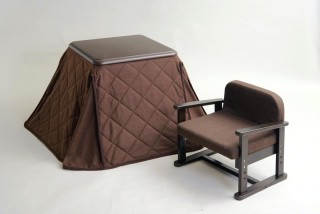Loading
Search
▼ Sales of Evolving Kotatsu Heat Up
- Category:Other
The Yomiuri Shimbun
The traditional kotatsu electric heater is a low table with a heat source underneath and a thick blanket on top so people can sit on the floor, often stretch out their legs underneath and get through the winter.
However, this type of kotatsu can be a bit hard on the elderly, who aren’t as flexible as young people. To address this problem, some companies have put new types of kotatsu on the market with higher table frames that permit the use of chairs. Some kotatsu are intended for those who live alone, too.
Yamazen Corp., an Osaka-based trading company dealing in home electrical appliances, put a kotatsu for single people on sale in autumn. Its table top measures 58 by 58 centimeters, smaller than standard kotatsu, while its height is 58 centimeters, higher than traditional types, so users can sit on low chairs. This kotatsu is available for ¥22,900 online.
Another type is 68 centimeters high and suitable for use as a dining table, as regular-size chairs can be used. This type of kotatsu is popular among elderly people who have leg or back problems, according to the company. One kotatsu does not need a blanket, as it’s equipped with a heater that emits more far infrared rays than other types so the warmth penetrates all areas of the body. Without a cover it’s easier to vacuum under and around it, and time and money are saved because there is no need to wash a blanket.
Koizumi Seiki Corp., an Osaka manufacturer of home electrical appliances, has come up with a product in which the heating device is inset rather than suspended from under the tabletop. This permits more legroom and makes it suitable for people who like to doze while lying on the floor and warming themselves under the kotatsu.
“You won’t hit your back even if you turn over while taking a nap,” a company employee said. The legs of the table can be changed to higher ones if needed.
Kotatsu sales have been declining since reaching a peak around 1980 because houses in Japan have been Westernized. Japanese-style tatami mats have been replaced with wooden floors and fewer people sit on the floor during their daily lives.
However, the kotatsu have garnered attention over the last few years as people have become more aware of conserving electric power by learning a lesson from the electric power crisis in the wake of the Great East Japan Earthquake.
Sally Kamihara, a commentator on home electrical appliances, emphasized kotatsu’s energy efficiency.
“The kotatsu consumes very little electricity and can warm the lower half of the body, which is more susceptible to the cold. If you use a kotatsu, you don’t feel the cold even if you turn down other types of heaters,” she said.
The traditional kotatsu electric heater is a low table with a heat source underneath and a thick blanket on top so people can sit on the floor, often stretch out their legs underneath and get through the winter.
However, this type of kotatsu can be a bit hard on the elderly, who aren’t as flexible as young people. To address this problem, some companies have put new types of kotatsu on the market with higher table frames that permit the use of chairs. Some kotatsu are intended for those who live alone, too.
Yamazen Corp., an Osaka-based trading company dealing in home electrical appliances, put a kotatsu for single people on sale in autumn. Its table top measures 58 by 58 centimeters, smaller than standard kotatsu, while its height is 58 centimeters, higher than traditional types, so users can sit on low chairs. This kotatsu is available for ¥22,900 online.
Another type is 68 centimeters high and suitable for use as a dining table, as regular-size chairs can be used. This type of kotatsu is popular among elderly people who have leg or back problems, according to the company. One kotatsu does not need a blanket, as it’s equipped with a heater that emits more far infrared rays than other types so the warmth penetrates all areas of the body. Without a cover it’s easier to vacuum under and around it, and time and money are saved because there is no need to wash a blanket.
Koizumi Seiki Corp., an Osaka manufacturer of home electrical appliances, has come up with a product in which the heating device is inset rather than suspended from under the tabletop. This permits more legroom and makes it suitable for people who like to doze while lying on the floor and warming themselves under the kotatsu.
“You won’t hit your back even if you turn over while taking a nap,” a company employee said. The legs of the table can be changed to higher ones if needed.
Kotatsu sales have been declining since reaching a peak around 1980 because houses in Japan have been Westernized. Japanese-style tatami mats have been replaced with wooden floors and fewer people sit on the floor during their daily lives.
However, the kotatsu have garnered attention over the last few years as people have become more aware of conserving electric power by learning a lesson from the electric power crisis in the wake of the Great East Japan Earthquake.
Sally Kamihara, a commentator on home electrical appliances, emphasized kotatsu’s energy efficiency.
“The kotatsu consumes very little electricity and can warm the lower half of the body, which is more susceptible to the cold. If you use a kotatsu, you don’t feel the cold even if you turn down other types of heaters,” she said.
- February 9, 2016
- Comment (0)
- Trackback(0)


